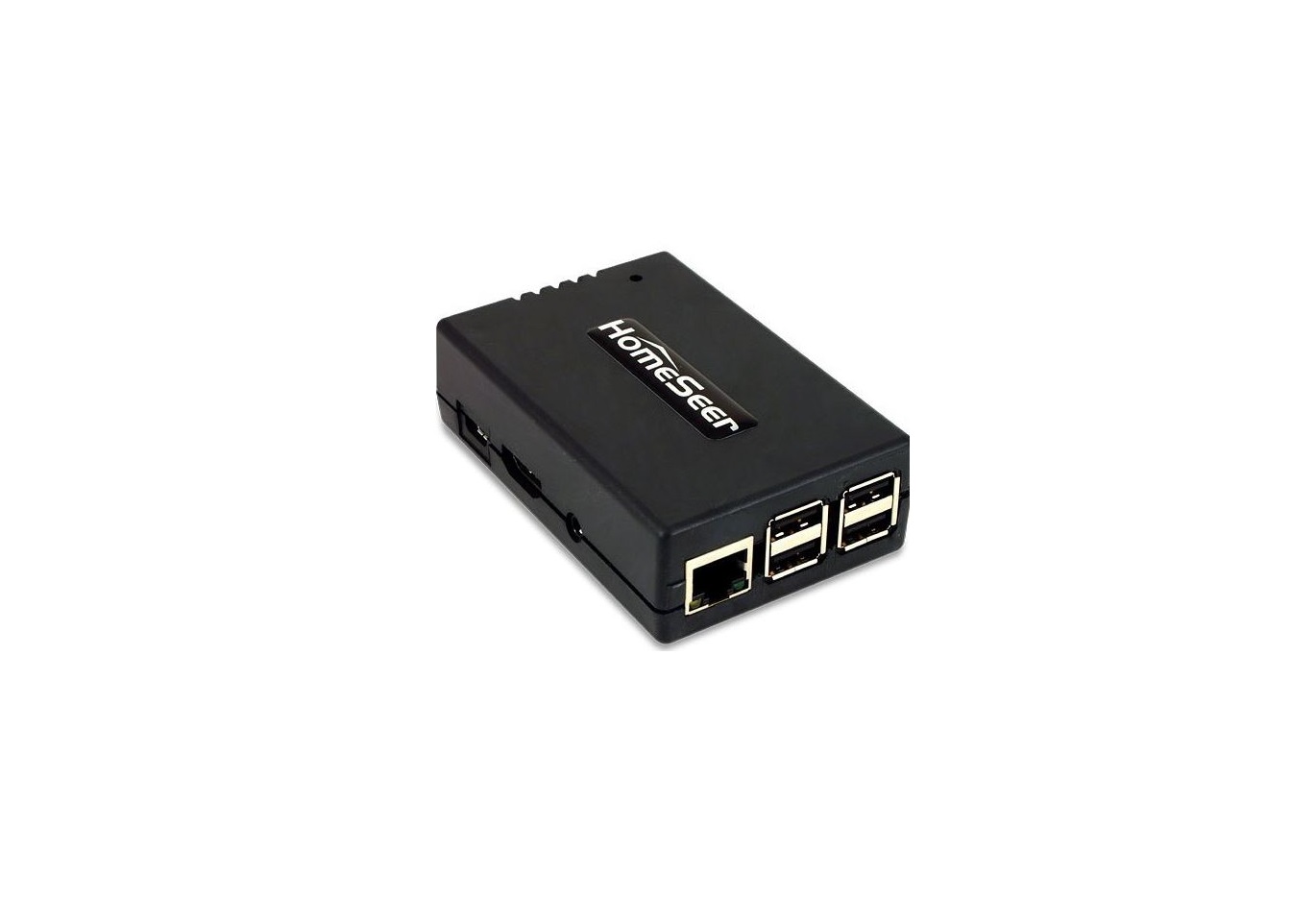HomeSeer HomeTroller Zee S2 User Guide

Congratulations on your purchase! Your HomeTroller Zee S2 is ready to put you in control of your home. Please take a few minutes to read through this guide to familiarize yourself with the steps required to set up your Z-Wave network and your new HomeTroller Zee S2.
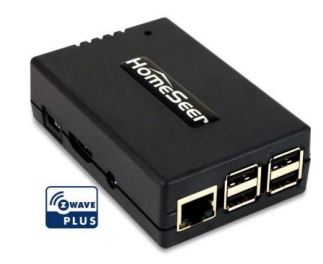
STEP #1 HomeTroller Zee Initial Setup
Hardware Installation
- Unpack the HomeTroller Zee, Ethernet cable and AC power supply.
- Connect the Ethernet cable to your HomeTroller Zee and to a network port on your internet router.
- Connect the AC power adapter to your HomeTroller Zee to begin the boot process. Allow the unit to boot fully (about 45 seconds to 1 minute).

Accessing the Web Interface
Once the unit boots, you’ll need to access the web interface to set the system up. The method below should work with any web-enabled device. We recommend using Google Chrome
- Navigate to http://find.homeseer.com
- Click the “Search” button. Your HomeSeer system should now appear at the bottom.
- Click the IP address hyperlink to access your system’s web interface.
Set Your System PasswordThe system password screen will appear the first time you run your HomeTroller Zee. You MUST set a system password to prevent unauthorized access to your unit. Please do this now by following the prompts on your screen. Choose a secure password that will also be easy for you to remember.
Activate and Register Your HomeTroller Zee OnlineBe sure to activate your HomeTroller Zee and register the unit to receive HomeSeer support. To do this, make sure your unit is connected to the internet and follow these steps:
- From the HomeTroller Zee web interface, use the pull down menus to navigate to the General Tab of the Setup Area (TOOLS > Setup)
- Click the “Register Online” button in the License section of the Setup screen and enter your license codes.Note: License codes are included on a sticker on the bottom of your HomeTroller Zee.
Update Your HomeTroller Zee and Set the Time Zone
- From the HomeTroller Zee web interface, use the pull down menus to navigate to the General Tab of the Setup Area (TOOLS > Setup). If an update is available, click the update button near to top of the page and wait for the update to download and install. Your HomeTroller Zee will automatically reboot once the update is installed.
- Access the General Tab of the Setup Area again and scroll to the “Location” area. Find the Time Zone field and change that to time zone where your HomeTroller Zee is installed. Example: US America/New York
Configuring the Wi-Fi Adapter
The Zee S2 comes with built in WiFi. If you wish to connect your Zee to your home network using WiFi. Follow these instructions to configure the WiFi adapter:
- Access the Network Tab of the Setup section. Locate the Wi-Fi Settings section.
- Enter the SSID (Wi-Fi network name) of your Wi-Fi. (This is case sensitive)
- Choose your encryption type and enter your Wi-Fi password. Keep `Use DHCP’ checked.
- Go to Tools->System->Shutdown System and shut the system down. Unplug the power and Ethernet cables.Now reconnect the power and let the system boot. 5. Using any browser-enabled device, access find.homeseer.com. Your WiFi connected HomeTroller Zee should now be accessible!
STEP #2 Setting Up Remote AccessMy HomeSeer Remote (“My HS”) is a FREE cloud service that will allow you to access your HomeTroller Zee from anywhere using a browser-enabled device or our HS Touch mobile app. Follow these instructions to set up My HS. See step 7 for access via your smartphone.
Register for MyHS
- Navigate to https://myhs.homeseer.com/Register
- Enter account information as shown on right. Check the sticker on the bottom of your HomeTroller Zee S2 to get your License ID and License Password.
- Click the Register Button.
- Check your email and click the verification link. Your MyHS account has now been created and your HomeTroller can be accessed any time at https://myhs.homeseer.com/
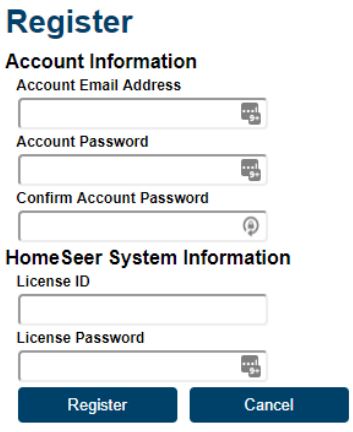
STEP #3 Installing Drivers (Plug-ins)Your HomeSeer system was designed to work with many different home automation technologies. Each technology requires a specialized hardware interface and software driver (“plug-in”). Your HomeTroller Zee S2 includes a built-in hardware interface for Z-Wave. Other hardware interfaces must be connected externally. Follow the steps below to enable the appropriate plug-in(s) for the technologies you wish to work with:
- From the HomeTroller web interface, open the Plug-ins menu and select Manage.
- Click the yellow circle before Additional Interfaces to open the listing of plug-in categories.
- Click the corresponding yellow circle before each category to browse the list of available plug-ins.
- To install a plug-in, simply click the checkbox before it and then click the “Download and Install” button in the section above.
- The installation process may take a few minutes. When done, your plug-in will now display in the “Installed Plug-ins” section at the top of the page.
- You must now Enable the plug-in and configure it with the correct COM port or IP Address setting, depending on the type of hardware interface installed. Refer to the hardware interface manual for details.
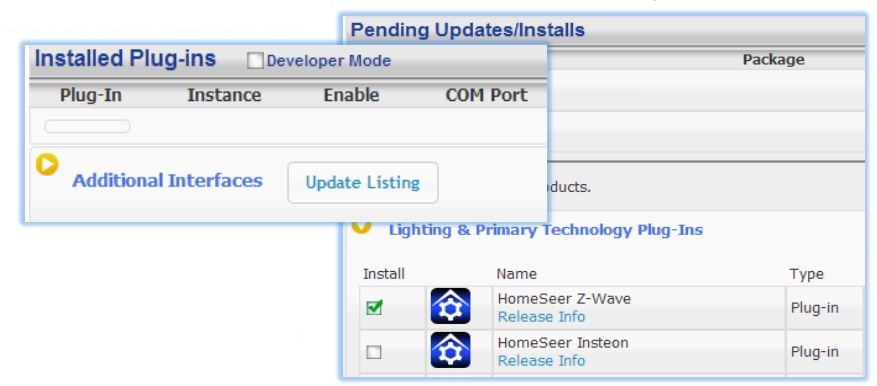
STEP #4 – Z-Wave Network SetupIn order to control Z-Wave devices, such as light switches, thermostats, door locks and sensors, they must be included into a Z-Wave “network”. Follow the steps below to create your Z-Wave network and to include devices. Note: the steps below assume you’ve already physically installed Z-Wave devices in your home.
Via Z-Tool+ (requires HS3 version 3.0.0.194 and Z-Wave version 3.0.1.23) To begin using Z-Tool+, the app must be downloaded from within your App Store. Open either the Play Store, iTunes Store, or Windows Store and search for `Z-Tool+’. The search will return the app and then just click Install. Click here for a more comprehensive guide to using Z-Tool+.
- a) Z-Tool+ will automatically find your system(s). Click Select a System if you have more than one local system.
- b) Select the Add or Remove action you wish you complete.
- c) Activate the network button (or button sequence) on your Z-Wave device and observe the inclusion process in the log window. Once removed a confirmation will show in the log.
- d) Once the Add process is finished a window will pop up to name and change the location attributes of the device.
- e) Your device can now be controlled via HSTouch or HS3 Web Control.
Via Web Control Page
Adding Z-Wave Devices (wall switches, receptacles, plug-in modules, sensors, door locks, etc.)
- a) From the web interface, use the pull-down menus and navigate to the Z-Wave Controller Management page (PLUG-INS > Z-Wave > Controller Management).
- b) Locate the “Z-Wave Interfaces” area and expand your Z-Wave Controller section. Open the “Actions:” menu and choose “Add/Include a Node”.
- c) Click the `Start’ button below the Actions menu. Your HomeTroller is now in inclusion mode and is ready to communicate with your device.
- d) Activate the network button (or button sequence) on your Z-Wave device and observe the inclusion process in the green log window. When done, you’ll receive an acknowledgement such as “Finished with Replication process” and a “Close” button will appear above the log window. Your Z-Wave device is now included into your Z-Wave network and can be controlled with your HomeTroller!
Removing (or resetting) Z-Wave Devices
Follow this procedure if you have difficulty adding a device or if you wish to remove a device from your network.
- e) From the web interface, use the pull-down menus to navigate to the Z-Wave Controller Management page (PLUG-INS > Z-Wave > Controller Management).
- f) Locate the “Z-Wave Interfaces” area and expand your Z-Wave Controller section. Open the “Actions:” menu and choose “Remove/Exclude a Node”.
- g) Click the `Start’ button below the Actions menu. Your HomeTroller is now in deletion mode and is ready to communicate with your device.
- h) Activate the network button (or button sequence) on your device and observe the deletion process in the green log window. When done, you’ll receive an acknowledgement such as “Finished with Replication process”. Your Z-Wave device has been reset and is removed from your Z-Wave network!
STEP #5 Editing and Controlling Your Z-Wave DevicesAfter you’ve created your Z-Wave network, you may wish to name your devices and assign them to appropriate locations. You may also want to adjust any available parameters or settings. Here’s how to do this:
Editing Your Z-Wave devices
- From the web interface, click on the Home page or navigate to the Device Management Page (VIEW > Device Management). Click the “Show All” button in the upper right-hand area of the page. A list of all your devices will now be displayed.
- To edit the device, click the corresponding hyperlink in the Name column. Name and location fields appear on the “Configuration” tab. Z-Wave parameters and settings appear on the “Z-Wave” tab.

Controlling Your Z-Wave devicesFrom the web interface, use the pull-down menus to navigate to the Device Management Page (VIEW > Device Management). Click the “Show All” button in the upper right-hand area of the page. A list of all your devices will now be displayed. Use the buttons, sliders and other controls in the “Control” column to test and control these devices.

STEP #6 Creating Automation EventsSimply put, an automation event consists of an action (or actions) that are set into motion by one or more triggers. Example: Turning on lights at sunset. Trigger = sunset, Action = turning lights on. With HomeTroller Zee, you can quickly and easily create all the events you need. Here’s how to create the sunset event above:
Creating Events
- a) From the web interface, use the pull down menus to navigate to the Events page (VIEW > Events).
- b) Change the event group name from “New Group” to “Lighting”.
- c) Now expand the “New Event” section and rename the new event to “Lights on at Sunset”
- d) In the shaded blue “Trigger” section, choose “The Time Is…” and then select “The Time is Sunset”
- e) If the shaded green “Actions” section, choose “Control a Device” and then select the device you wish to control and the method of control (on / off) you wish to use. The resulting event will look like this:
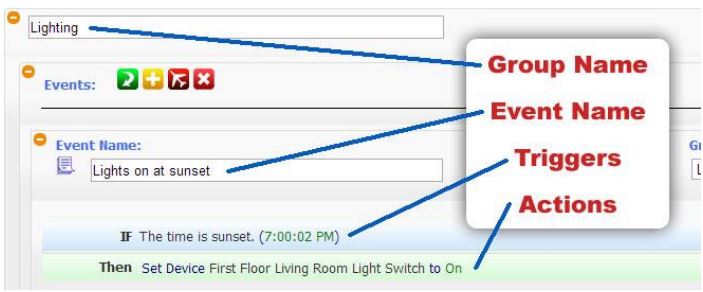
STEP #7 HomeSeer MobileAfter you have successfully created a MyHS account and have the unit on your local network, you can connect to your unit via our mobile application. HomeSeer Mobile is required to access your HS3 system via a mobile device. HomeSeer Mobile is not required to connect via the MyHS website.

In order to use the latest HS Mobile app, first visit the Play Store on Android or the App Store on iOS. You can use the buttons below to quickly find the app or open up your App Store and search for “HomeSeer Mobile”
REQUIRES VERSION 3.0.0.500 OR HIGHER OF HS3
Once HS Mobile is installed and opened, you will be prompted to enter your MyHS account name and password. If you do not already have an account, please view this guide or go back to Step 2, which will walk you through the process of setting that up.
Once you have your account credentials, tap Log In, and you will be connected to your HomeSeer system. Select Remember me if you wish to have your credentials saved. If you have a premium MyHS subscription, you will see a list of your systems that you can connect to. If you would like to learn more about the Premium MyHS subscription, please click here.

For a more customized experience, check out HSTouch Designer at homeseer.com.


 Cloud Service IntegrationAmazon AlexaPlease visit https://homeseer.com/amazon-alexa-integration for instructions on integrating your Alexa devices. Step 2 is required in order to utilize Alexa.
Cloud Service IntegrationAmazon AlexaPlease visit https://homeseer.com/amazon-alexa-integration for instructions on integrating your Alexa devices. Step 2 is required in order to utilize Alexa.
Google HomePlease visit https://homeseer.com/google-home-integration for instructions on integrating your Google devices. Step 2 is required in order to utilize Google Assistant.
IFTTTPlease visit https://homeseer.com/ifttt-integration for instructions on integrating IFTTT recipes. Step 2 is required in order to utilize IFTTT.
TROUBLESHOOTING
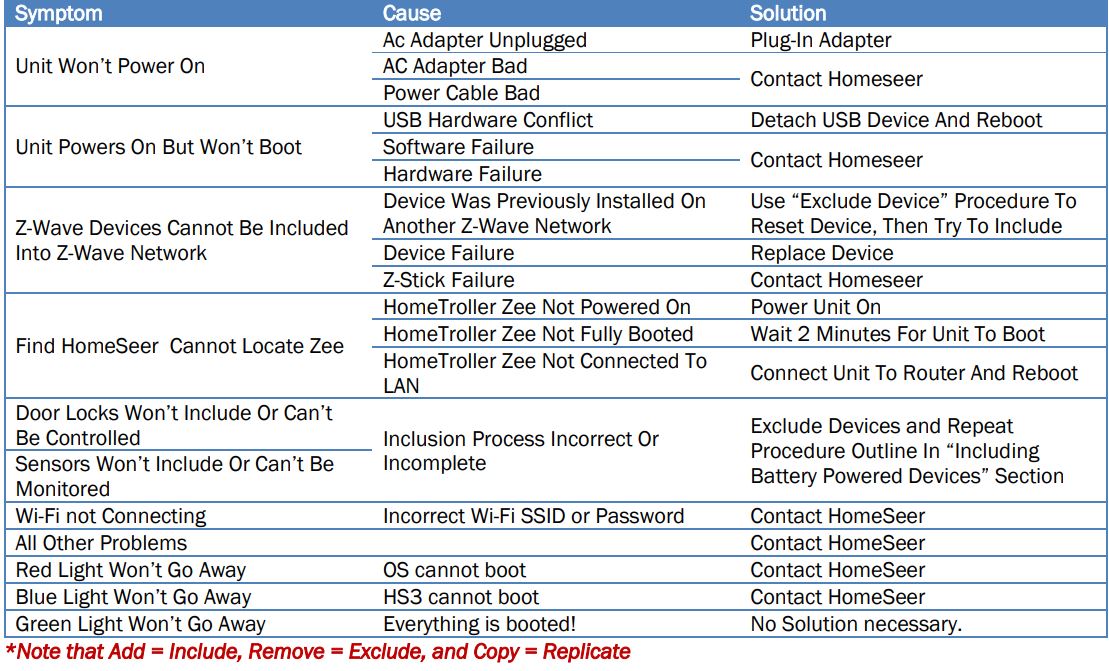
HS3 Recovery ProcedureUse this procedure if your HomeTroller becomes unresponsive or inaccessible.
- With a browser-enabled device, enter the IP address followed by “:911”. Example: http://192.168.2.50:911 This screen at right will appear >
- Option 1: Use this option if you cannot access your system due to forgetting username, changing settings that cause HS3 to not boot correctly, or enabling a plug-in that may cause HS3 to crash.
- Option 2: Use option 2 if you want to revert back to an update or update to the latest version.
- Update HS Recovery Utility: Use this to check for updates to your Recovery page with added recovery options.
- Return to HS: This will bring you back to find.homeseer.com to find your HS3 system.
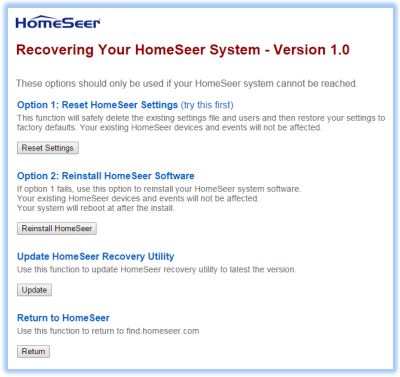
HomeTroller Zee System Restore ProcedureUse this procedure only after the 911 features do not fix your problem and you have contacted HomeSeer support. This procedure will wipe your existing data. Make sure to BACKUP your HS3 configuration by going to Tools->Setup.
- Plug in a monitor and keyboard to your Zee.
- Restart your Zee and wait for the prompt that says For recovery mode, hold Shift.
- Once the restore loads, a screen will load shortly allowing you to select the Zee S2 Factory Image.
- Select the Factory Image and click Install at the top left.
- Once finished click OK and your Zee will reboot.
HomeTroller Zee Reset Network Settings
- Connect a keyboard to the unit and reboot your Zee S2.
- Press R (lower care or upper both work) and then press Enter when the light turns yellow.
- If the light turns blue, your settings were successfully reset.
Icon Legend for HS3.
![]()
HomeSeer | 10 Commerce Park North, Unit #10 | Bedford, NH 03110 www.homeseer.com | 603-471-2816
More Helphttps://homeseer.com/support-home/
This product employs or practices certain features and/or methods of the following U.S. Patents: U.S. Patent Nos.6,891,838, 6,914,893 and 7,103,511.
References
Log in – MyHS
Smart Home Systems For Every Need & Budget | HomeSeer
Smart Home Systems For Every Need & Budget | HomeSeer
find.homeseer.com
HomeSeer Mobile on the App Store
Amazon Alexa Smart Speaker Integration | HomeSeer
Amazon Alexa Smart Speaker Integration | HomeSeer
Google Assistant Integration | HomeSeer
MyHS Plans – HomeSeer
IFTTT Integration | HomeSeer
HomeSeer Mobile – Apps on Google Play
Smart Home Systems For Every Need & Budget | HomeSeer
Support Home Page | HomeSeer
Register – MyHS
[xyz-ips snippet=”download-snippet”]

